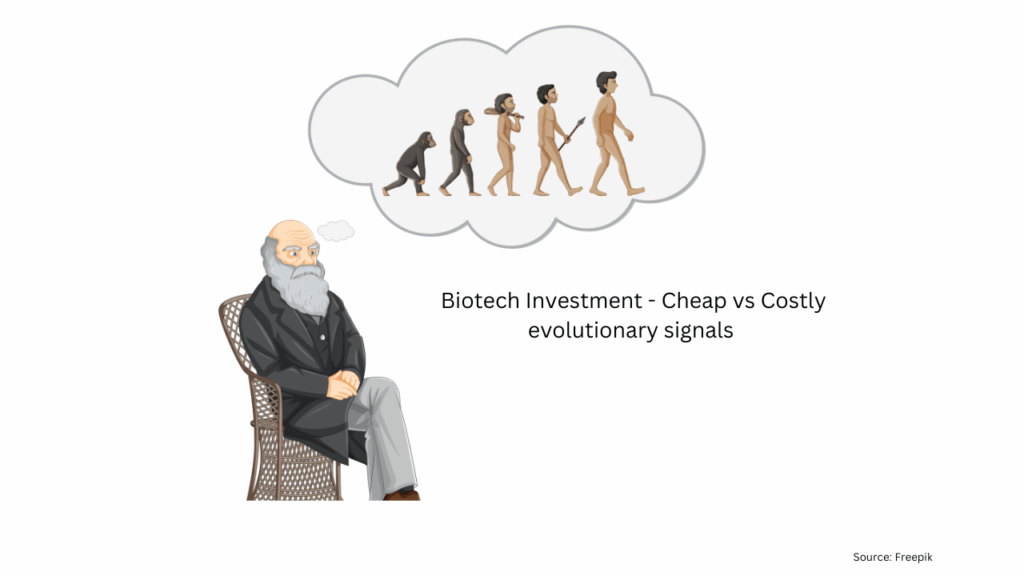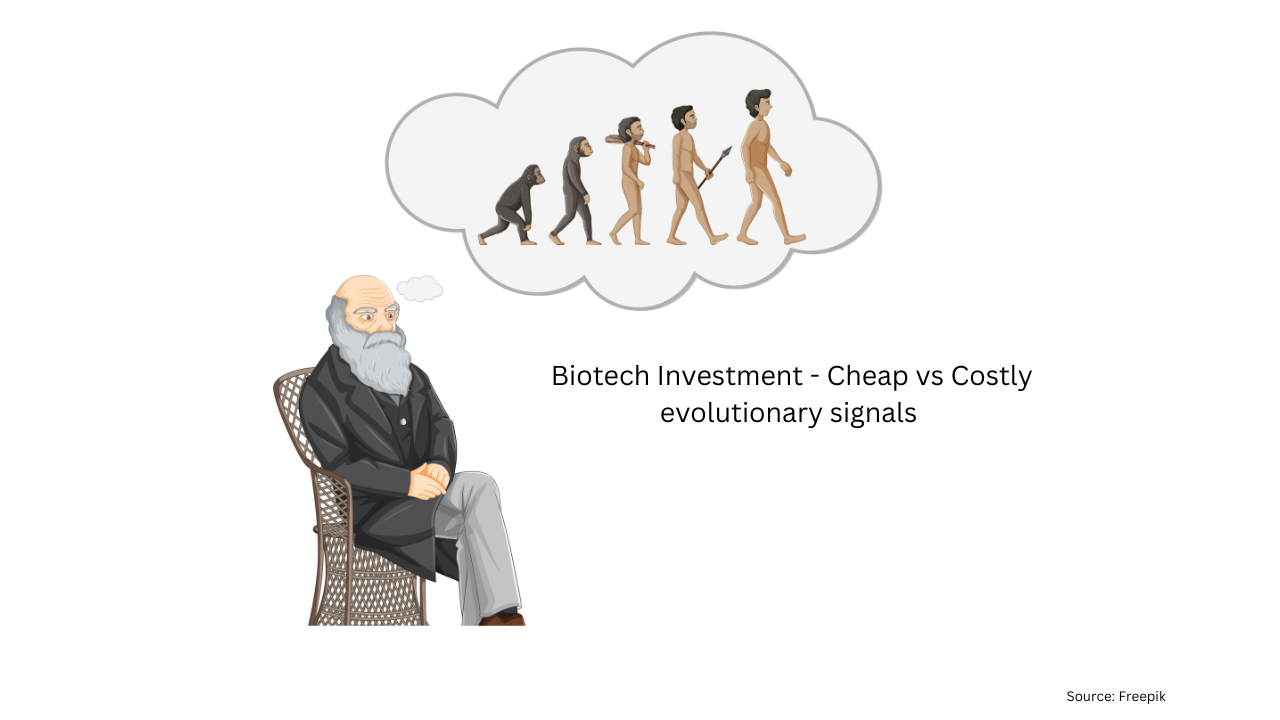Biotech Investment – Separating wheat from chaff through evolutionary theory
Assessing whether to invest in therapeutic companies poses a challenge, particularly due to the limited historical data available—either non-existent or insufficient for a thorough evaluation. Unlike revenue-generating companies, which benefit from parameters like ROIC to gauge capital reinvestment, therapeutic companies lack such metrics. In revenue generating companies we have parameters such as ROIC[1] that allows us to see how the company has been reinvesting its capital. A company with consistent ROIC greater than 20-30% for more than 8-10 years can be considered a great company (in general).
In the absence of comprehensive investment evaluation tools, one recourse is to utilize signals for rejection. Drawing an analogy to animal behaviour, where signals play a crucial role in survival, investors can use signals to sift through potential investments.
Every animal emits signals for various purposes, such as attracting mates, warning family members of danger, or attacking prey. In light of Darwin’s theory of survival of the fittest, despite the prolonged evolution that has refined the signalling skills of animals and plants over millions of years, there persists a constant competition for resources. This includes strategies to outperform others in acquiring food and deceiving predators through camouflage. As a result, animals engage in emitting both honest and deceptive signals as part of their survival tactics.
For example: Large male green frogs emit croaks at lower frequency to show their dominance to small sized frogs and gain evolutionary advantage. However, some small sized frogs have found a way to lower their signals communicating to both the large frogs and the females that they are larger than they are, leading to their evolution. Similar story goes for Fiddler crabs who leverage their large claws to attract females and show their prowess to males. It is known that when they lose their claws in the fight, they regrow but the new ones are weaker and lighter. However, females as well as male crabs are unable to differentiate between the impostor and the crab with real strong claws. That’s another dishonest signal for you.
Consider another group of animals, like male Guppies (fish), which display vibrant colours to attract female Guppies. The vivid and colourful hues are attributed to carotenoids, a class of pigments known for fortifying the immune system and acting as antioxidants. Research has demonstrated that female finches are drawn to male finches exhibiting rich, deep red colours, a result of consuming nutritious food compared to their counterparts with less nutritious diets. However, it’s noteworthy that this intense red coloration comes at a cost, as the brightness also attracts predators to these vibrant individuals.
Bottom line: Sending out this sincere signal necessitates the fish or the finch to consume nutritious food, promoting the accumulation of carotenoids, resulting in improved health and more vibrant colours. While conferring an evolutionary advantage, it is a double-edged sword, as it also becomes a perilous act, attracting predators in the process.
Hence this is a costly signal and it’s not easy to emit those.
Similarly, we can evaluate biotech companies by looking at the leadership that emits signals that are costly to produce[2].
What are the cheap signals that we could use to assess for not investing?
- Tortoise vs hare: Can you identify a couple of companies you came across seven to eight years ago that, while still in existence, seem to have made little progress or remain in the same phase? Alternatively, they may not have reached the clinical stage, leaving you curious about their current endeavours. I know I know; we have learnt from Tortoise vs Hare story how slow and steady wins the race. However, if over these years a company fails to enter clinical stages or demonstrate expected advancements, it implies a subtle erosion of value, presenting a less robust signal to potential investors.
- Virtue signalling: Social media has allowed us to scale the content of people who write very well or have certain exceptional qualities; however, it has also exposed our narcissistic attitude and virtue signalling where we make videos when we give food to the poor, make announcement of company progress – including team dinners, lunch and breakfast like a trader watching the stock price every minute etc. So, Virtue signalling, often observed through excessive communication on irrelevant matters, can be deemed a cheap signal as it requires minimal effort.
What are other signals in your opinion that are cheaper to produce? Please comment below.
What are the Signals that are costly to produce?
- Skin in the Game: Although investing in a classic therapeutic company is not a cup of tea as its very capital intensive, nevertheless an entrepreneur fully committed to this new initiative by leaving his fat salary is a costly and honest signal. Putting a portion of his savings for conducting a small study or paying his collaborators through his pocket reflects his skin in the game and is a costly signal.
- Capital efficiency: An assessment of the time and financial resources required to reach the first inflection point, juxtaposed against industry standards, reveals the CEO’s level of urgency and the competitive advantage of the company. This evaluation of capital efficiency serves as a valuable indicator of the company’s strategic strength and operational effectiveness.




